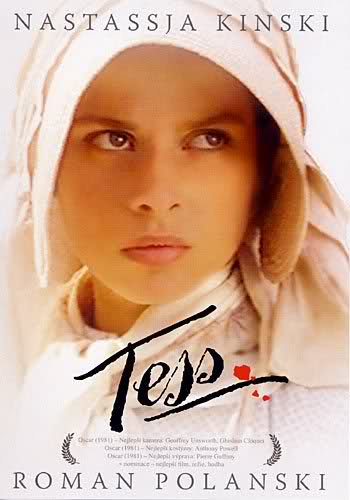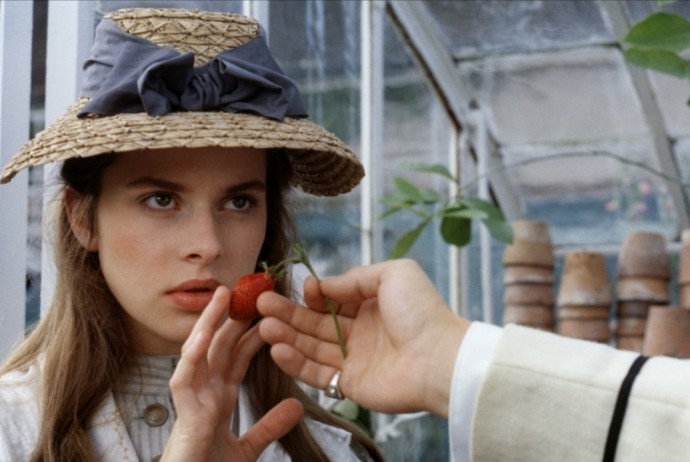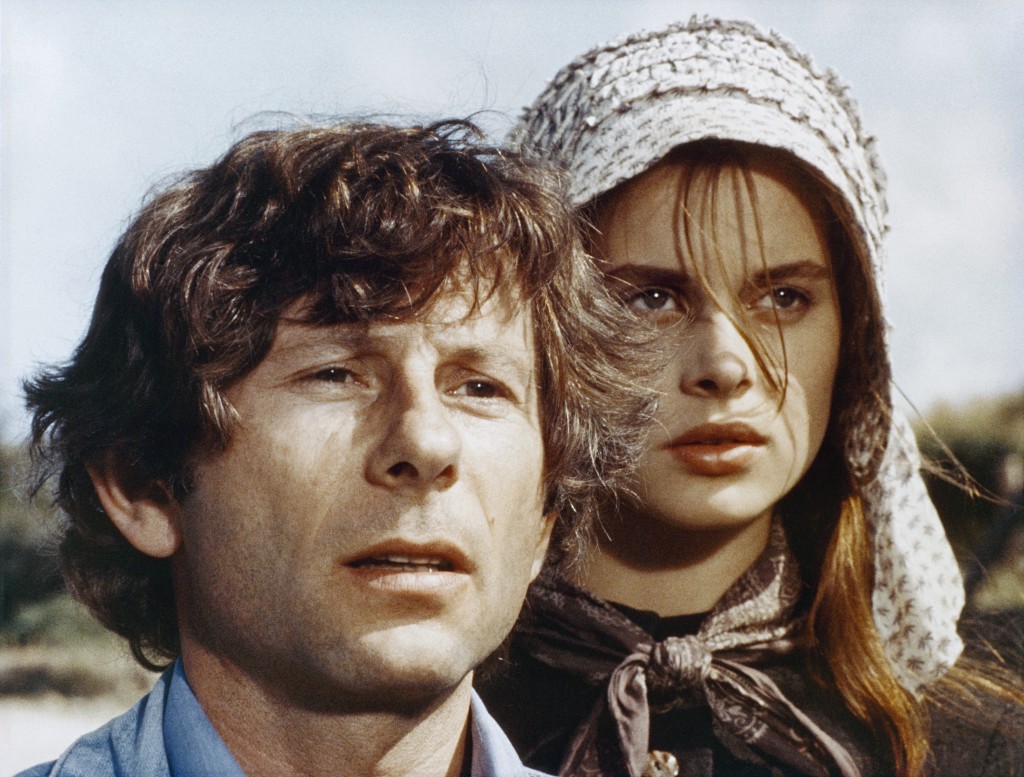Dir: Roman Polanski
Star: Nastassja Kinski, Peter Firth, Leigh Lawson
You can hold your own for beauty against any woman, Queen or commoner. I tell you that as a practical man who wishes you well. If you’re wise, you’ll let the world get a clearer sight of that beauty – before it fades…
— Alec Stokes-d’Urberville
This was the first Kinski film I saw which required a significant amount of full-on acting, and it was a revelation. While it was Kinski’s presence that initially drew me in, I was blown away by just about every aspect, from the cinematography to the score, and I still regard as an all-time classic, 25 years after first seeing it. Thomas Hardy’s book – which I subsequently read – is one of the greatest tragic stories in English literature, and Polanski’s version does it complete justice.
Its origins are in the violent mayhem which struck Hollywood in August 1969, when Polanski’s wife, actress Sharon Tate, then 8½ months pregnant, was among the victims of Charles Manson’s “family.” The last time Polanski saw Tate, she supposedly gave him a copy of Hardy’s novel, telling him it would make a great film. Tate had herself been given the book by Julie Christie, inscribed “For my Hardy heroine” – Christie had been one of those herself, starring in John Schlesinger’s 1967 adaptation of Far from the Madding Crowd. The resonance of Tate with Tess, both losing a child and their life in terrible circumstances, doesn’t need to be spelled out.
“The thing that attracted me most to this novel is the theme of fate: the heroine has everything she needs to make her happy. However, the social context in which she lives and the unrelenting pressures weighing down on her lock her into a chain of events that lead to her tragic end.”
— Roman Polanski
Polanski and Kinski had known each other well before the movie. Their relationship began when she was just 15 – by some reports, the first significant relationship since Tate’s death – and it’s a spooky coincidence that both Kinski and Tate were born on January 24th, eighteen years apart. There’s some doubt as to whether they were still together during filming. One reports says, “Their own affair wrapped about simultaneously with Tess,” but according to Polanski, “From the time I started the film with her, we were like brother and sister.” Kinski concurred: “It was just a romance. I fell out of love with Roman after a while because something bigger grew—a real understanding. He’s like from my family.”
It was a production fraught with issues. Because Polanski had fled legal proceedings for statutory rape in the United States, the film could not be shot in England, where Hardy’s story took place, for fear of extradition. Instead, Locronan. in French Brittany, stood in for Wessex, but the need to capture all the seasons led to a nine-month shooting schedule and resulted in the film becoming the most expensive produced to that point in France. Weeks were lost to a strike by French crew members, and original cinematographer Geoffrey Unsworth died in the middle of the shoot. Apocryphally, when producer Claude Berri’s wife was asked how her husband was sleeping, given all these problems, she replied: “Like a baby – he wakes up crying every hour.”
Also raising eyebrows was the decision to cast a teenage German girl in the central role. Kinski was sent to London for five months of dialect study and Polanski also sent Nastassja to Lee Strasberg’s studio. She says, “He took a lot of time, two years, preparing me for that film.” Quite a number of reviewers were unimpressed by the effort – one described her accent as “bewildering,” another said it “deeply marred” her performance – but it seems pretty damn close to me, certainly good enough and never took me out of the moment. The same can be said for the length: I tend not be a fan of movies that go beyond 2 1/2 hours in length, since they always seem overstuffed and superfluous. That’s not the case here: every scene is necessary, and I never even glanced at the time.
Backing up Kinski’s performance are those of Lawson and Firth, portraying the two men in her life. First, there’s Lawson as Alec, who sets his sights on conquering her, from the first time he sees her. Yes, he’s a total cad, but Alec is at least consistent, and doesn’t make much of an effort to conceal his true nature. While there obviously can be no excuse or defense for his assault on her, he shows himself willing to do the right thing, and take care of both the child spawned from his loins, and Tess herself in the long term. You could argue that it’s the heroine”s pride and defiance, which makes that task far more difficult than it should be.
Angel (Lawson) is arguably a worse villain, because his facade of propriety is shown to be nothing more than hypocritical sham, when Tess finally gets the courage to detail her past. That’s not for want of trying either: possibly the most awful moment in the film is when she discovers the note she left for him, slipped under the carpet unseen. As she descends to ground, crumpling the note, the sun flares up behind her into the lens in a brilliant moment of cinematography (whether fortunate or planned), incinerating everything., including our heroine’s happiness. It’s little wonder Tess looks like a deer caught in headlights at her wedding, terrified for the future.
She’s absolutely right to be concerned, because Angel’s reaction to her confession is to turn into Mr. Bastard, telling Tess, “You are not the woman I loved…[but] another woman in her shape.” He becomes even more scathing from there: “I cannot help associating your lack of firmness with the decline of your family. Decrepit families imply deficient willpower and decadent conduct. I thought you were a child of nature. But you were the last in a line of degenerate aristocrats.” The double-standard here is clear, having just confessed about a premarital relationship of his own – and one which was, unlike Tess’s, apparently entirely consensual.
 He storms off and heads for Brazil, but as he leaves, has a chance encounter with Izz, one of his wife’s colleagues from the dairy, who always held a candle for Angel. He asks if she’d come with him, but the resulting conversation is another dagger, this time to Angel’s heart, and one too late to repair:
He storms off and heads for Brazil, but as he leaves, has a chance encounter with Izz, one of his wife’s colleagues from the dairy, who always held a candle for Angel. He asks if she’d come with him, but the resulting conversation is another dagger, this time to Angel’s heart, and one too late to repair:
“Do you love me so much?”
“I’ve… I’ve always loved you.”
“More than Tess?”
“No. Not more than her. Nobody could have loved you more than Tess. She’d have given her life for you. I could do no more.”
That’s just one of a number of heart-wrenching scenes that are just intense to watch – the most traumatic of which is perhaps Tess pleading with the local vicar to allow her baby, baptized only by its mother, to be buried in the local churchyard. [I probably shouldn’t say this, but I suspect the child probably died of starvation: let’s just say, the scene of Nastassja breast-feeding, suggests not enough nutrition for a field-mouse…] The entire film is an emotional roller-coaster like that – except there’s a lot more down than up. In fact, it’s more like an emotional Tower of Terror.
All the pieces mesh perfectly, even the cinematography where, as mentioned above, Geoffrey Unsworth died during filming, and was replaced by Ghislain Cloquet (who also passed away, a few months after completing hs work) . You can probably tell the differences in style, and figure out who shot what, if you know the hallmarks to look for, but you’d never know it otherwise, with their styles complementing each other. Right from the off, Phillipe Sarde’s score is right there alongside the viewer, propelling and crafting emotions in almost every scene – I’m not able to hear the lullaby, Bye, baby Bunting, without thinking of the film, due to Sarde’s variations on the theme.
The film was a critical hit, snaring six Oscar nominations and winning three – Unsworth and Cloquest shared for Cinematography, and it also won for Art Direction and Costume Design. Inexplicably, it lost out for Best Score to Fame, and for Best Picture to Ordinary People, whose director Robert Redford also beat out Polanski. Commercially, it was less successful, at least in North America where Polanski’s reputation probably hurt it more, with a take there of fractionally over $20 million, compared to its budget of $35 million. However, it did well in most of Europe, for example taking in about $7 million in the UK. Certainly, it performed a lot better than Polanski’s next film, Pirates, so I trust Berri was able to sleep eventually!
As for Kinski, it made her an international star, though her acclaim was less. She was nominated for a César, and won the Golden Globe for New Actress [though to put the latter into context, in the next two years, the same award went to Pia Zadora and Sandahl Bergman, before the plug was pulled on the category entirely!] But she did pay a price for the fame the movie brought her. Two years later, she was still “taking a daily rubdown for back problems caused by the tight corsets she wore” during the filming. That’s suffering for your art.

